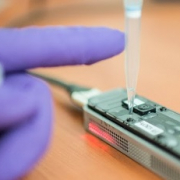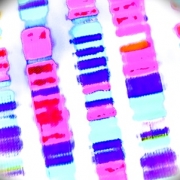Genome sequencing – past, present and future
How has sequencing evolved? And will whole genome sequencing replace other technologies as clinicians’ go-to diagnostic test?
 The power of whole genome sequencing (WGS) was beautifully illustrated this month by the provision of genetic diagnoses for two children participating in the 100,000 Genomes Project. Both Jessica Wright and Georgia Walburn-Green have previously undiagnosed rare genetic disorders, and their respective diagnoses have enabled medical staff and their families to make decisions about the future which would otherwise have been unavailable. So, given its potential to change lives so profoundly, is WGS likely to become key in clinical diagnostics? And, if so, where should it be positioned in the patient testing pathway? Fiona MacDonald considers.
The power of whole genome sequencing (WGS) was beautifully illustrated this month by the provision of genetic diagnoses for two children participating in the 100,000 Genomes Project. Both Jessica Wright and Georgia Walburn-Green have previously undiagnosed rare genetic disorders, and their respective diagnoses have enabled medical staff and their families to make decisions about the future which would otherwise have been unavailable. So, given its potential to change lives so profoundly, is WGS likely to become key in clinical diagnostics? And, if so, where should it be positioned in the patient testing pathway? Fiona MacDonald considers.
Evolving technologies?
Sequencing has traditionally involved the analysis of one gene at a time – a limitation imposed by technology and throughput as well as cost. In patients without a clearly defined phenotype (observable clinical characteristics), clinicians have in the past requested testing of genes in a sequential manner, with implications for time taken to reach a diagnosis – if indeed one was made at all. The emergence of faster, higher-throughput next generation sequencing (NGS) technologies has led to new diagnostic strategies with increasing levels of complexity, each with its pros and cons. These include panel testing, whereby between two and several hundred genes are sequenced in parallel, as well as whole exome sequencing (WES) and full-scale WGS – the approach used by Genomics England to reach a diagnosis for both Jessica and Georgia.
These technologies have evolved over time, with each building on the capabilities of the last and delving further and further into the genome. But it would be misleading to suggest that the latest development – WGS – should be used in every case. Each of these sequencing approaches has its place in clinical diagnostics, and the technology used will depend on the clinical question.
Panel testing
Panel tests designed to interrogate a set of disease-associated genes have been shown to be cost-effective and ideal in certain circumstances. Good depth of coverage (each fragment of DNA is sequenced many times) and high sensitivity and specificity for mutation detection are particularly valuable features when a mutation is present at a low level – for example in tumours.
At a recent meeting hosted by the UK Genetic Testing Network and British Heart Foundation the advantages of panel testing were highlighted1. Speakers pointed out that as the process interrogates small numbers of genes with an established role in the disease in question, interpretation of variants – particularly unclassified variants – is easier. Increasing the number of genes analysed leads to an increased mutation detection rate, but also increases the number of variants of unknown clinical significance that need to be considered. For these reasons, panel testing remains a highly valuable tool, especially when seeking a diagnosis for conditions with well-defined phenotypes.
Whole exome and whole genome analysis
Whole exome sequencing (WES) analyses the protein encoding regions of the genome (1-2% of the total), within which an estimated 85% of causative mutations are thought to occur. WES has been an invaluable tool in gene discovery, with over 800 genes related to monogenic disorders found in this way. In clinical laboratories, it is becoming a more commonly applied approach, often used initially for sub-panels of genes rather than the whole exome. However, if no causative mutation is identified, the remainder of the exome data can be analysed. Linked to this approach is the investigation of the ‘clinical’ exome, which looks only at those genes previously reported in association with a clinical phenotype.
One disadvantage of WES is that it requires an initial sequence capture step to enrich for the coding sequences. As some regions of the exome are less amenable to capture, sequencing coverage is not complete, with approximately 5% of the exome excluded from analysis. The depth of coverage is also less uniform that with other technologies, such that analytical sensitivity may be lower for some genes than others.
WGS has still not been introduced into routine diagnostics, although this is likely to change, particularly as one aim of the 100,000 Genomes Project is to leave a legacy for diagnostic laboratories. WGS is better at detecting structural variants and copy number changes in addition to single nucleotide variants and insertion/deletion mutations, and coverage is more even as no pre-enrichment step is required.
The data deluge
The major challenge facing clinicians using these technologies is the sheer volume of data to be interpreted. WES will typically identify tens of thousands of genetic variants, whereas WGS will identify millions in each individual. Filtering strategies to remove variants which are known to be benign, or those of no known clinical significance, are applied, but investigation of the rest can nonetheless be a significant undertaking.
In addition, variant interpretation is very complex, particularly as analysis at such a detailed level is in its infancy. Many of the genes in which mutations are found will not have been previously linked with a condition, making assignment of causality tricky and often impossible. In order to facilitate analysis of these large data sets and expand expert knowledge, Genomics England has developed PanelApp , which features virtual gene panels created from a variety of reliable sources that can be used to ‘rate’ variants detected by WGS. The panels are open to review by experts in the field, so that groups of genes can be prioritised for diagnosis of a given disorder.
Additional and incidental findings
In analysing exomes and genomes there is the possibility of detecting not just the causative mutation but also mutations in genes that are unrelated to the patient’s symptoms – so called incidental findings (IFs). The ACMG has recommended reporting some of these findings in relevant genes with a medical benefit2. Genomics England uses the term ‘additional findings’ to describe mutations in genes that will be actively investigated as they are considered to be important for individuals’ healthcare. Such results will be fed back to those taking part in the 100,000 Genomes Project who consent to receive this information, whereas IFs in other genes will not be fed back.
Overall whole exome and genome sequencing have obvious benefits in improving our ability to diagnose genetic causes of disease – but they bring their own challenges. For some patients, they are likely to become the first-line test to increase the probability of successful diagnosis, but simpler technologies are likely to remain in use for those with clinically distinct presentations.
- ukgtn.nhs.uk
- Green RC et al. Genetics in Medicine 2013; 15(4): 565-574.
–









